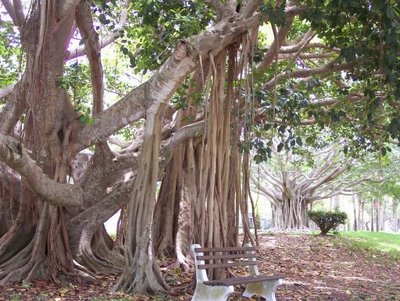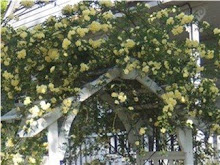 Banyan (genus: Ficus subgenus: Urostigma) is a subgenus of many species of tropical figs with an unusual growth habit. They are large trees that usually start life as a seedling epiphytic on another tree (or on structures like buildings and bridges), where a fig-eating bird has deposited the seed. The roots descend over the trunk of the host seeking out the soil below, once they have rooted into this the fig roots rapidly thicken and lignify. Where the fig roots cross each other they fuse, thus creating a lattice around the host tree's trunk. The fig competes with its host for light, water and nutrients, while its roots prevent the host's trunk from growing. Eventually the host dies and rots away, leaving the fig self supporting as an ordinary tree, but with a tubular lattice of lignified roots instead of a trunk. For this reason banyans are often referred to as strangler figs.
Banyan (genus: Ficus subgenus: Urostigma) is a subgenus of many species of tropical figs with an unusual growth habit. They are large trees that usually start life as a seedling epiphytic on another tree (or on structures like buildings and bridges), where a fig-eating bird has deposited the seed. The roots descend over the trunk of the host seeking out the soil below, once they have rooted into this the fig roots rapidly thicken and lignify. Where the fig roots cross each other they fuse, thus creating a lattice around the host tree's trunk. The fig competes with its host for light, water and nutrients, while its roots prevent the host's trunk from growing. Eventually the host dies and rots away, leaving the fig self supporting as an ordinary tree, but with a tubular lattice of lignified roots instead of a trunk. For this reason banyans are often referred to as strangler figs.Another unusual feature of the banyan is its ability to produce adventitious roots from the branches. This characteristic of developing aerial roots allows a single tree to spread over a large area. The biggest banyan tree in Pune, India is said to measure 800 m around its perimeter. Another famous banyan tree was planted in 1873 in Lahaina's Courthouse Square in Hawai'i, and has grown to now cover two-thirds of an acre. The single largest unity of Banyan tree in the world is in Howrah (West Bengal) in Botanical Gardens with a width of 420m.
Like other members of this genus (which includes the common edible fig Ficus carica), banyans have a unique fruit and insect mediated fertilization process.



































1 comment:
Those are fascinating; I don't recall ever seeing anything like them!
Post a Comment